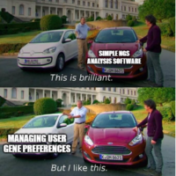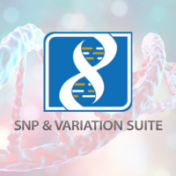This month, we are excited to announce that we have received the certification for ISO 13485:2016 from TÜV SÜD. ISO 13485:2016 is an international standard that specifies requirements for a quality management system (QMS) for organizations involved in the design, development, production, and servicing of medical devices. It is specifically tailored to the medical device industry and is recognized globally… Read more »
Welcome to the exploration of groundbreaking genetic research in ophthalmology. Recent studies have unveiled fascinating insights into the complex interplay between genetics and eye disorders, offering hope and new directions for understanding and treating these conditions. From novel genetic variants linked to microphthalmia and glaucoma to the long-term implications of cataract surgery in childhood, we’re diving into the depths of… Read more »
We are excited to announce the release of our gnomAD v4 annotation tracks for VarSeq. This version of the GnomAD database represents a significant leap forward, including data from an impressive cohort of over 800,000 individuals — a remarkable 5x expansion compared to the previous releases. Notably, this dataset is comprised of two distinct callsets: exome sequencing data from 730,947… Read more »
Today, we will be exploring the indispensable role of GenomeBrowse in your VarSeq workflows. This blog aims to guide you through various customization options, including color preferences, filtering techniques, display modifications, numeric value plotting, and additional tips. I hope to enhance your GenomeBrowse experience and enable you to gain valuable insights into your data. Let’s jump in by talking about… Read more »
The latest VarSeq release offers enhanced control over genome browse visualization computations. These computations, which are responsible for computing and caching coverage files that create the aggregate view of tracks within GenomeBrowse, are now more flexible. Typically, these tracks create files with the “.covtsf” extension and are used for zoomed-out density views of sources like VCFs and BAMs. Managing Automatic… Read more »
Many thanks to those who came to view our most recent webcast, From Panels to Genomes with VarSeq: The Complete Tertiary Platform for Short and Long-Read NGS Data. This was a great opportunity for us to showcase the breadth of our workflows, from short-read to long-read, panels to genomes, singleton analysis to families. In this blog, we would like to… Read more »
There are several contextual factors to consider when analyzing genomic data for NGS analyses. A variant may have divergent impacts depending on which transcript of the gene is being considered, or the impact of a variant could be weighed more or less heavily depending on the disease context. Evidently, the user’s gene preferences are very important, but not all software… Read more »
How long did it take to run coverage regions? Did my colleague update the filter chain like he said he would? Which import options did I use? Where did I save this project? These questions and more can be answered with our little-used VarSeq Log tab. Periodically, our customers come to us with questions in the realm of record keeping,… Read more »
Happy New Year! I hope that you all were able to enjoy quality time with loved ones over the holidays. 2023 has come to a close, and we would like to take the time to thank you while looking back on a year full of accomplishments. In 2023, we celebrated our 25th anniversary. This is a major milestone for any… Read more »
Get your year started off right with Golden Helix’s new VarSeq Onboarding and Training Program! Analysis of NGS data comes with several challenges, but mastery of the data analysis software does not have to be one of them. With this in mind, Golden Helix is pleased to announce that VarSeq Onboarding and Training tools are now available to all our… Read more »
In this blog, we explore the impactful applications of VarSeq in genetic research and diagnostics. Through case studies, we examine its role in diverse conditions like Immune Mediated Thrombocytopenia (ITP), glaucoma, and Cri du Chat syndrome. These studies demonstrate VarSeq’s capability in identifying genetic variants and influencing diagnosis and treatment across various medical scenarios, showcasing its crucial role in advancing… Read more »
Thank you to those who attended our recent webcast on Golden Helix’s SNP & Variation Suite (SVS) and its new capability related to Polygenic Risk Scores (PRS). If you were unable to attend, a recording can be found via this link. For common diseases, PRS can provide a predictive value related to the disease risk at an individual level. By… Read more »
VarSeq Warehouse is the solution provided by Golden Helix for management of large-scale genomic data. It serves a centralized, indexed variant repository that stores variants and assessments from selected samples or projects. Management of large-scale genomic data with VSWarehouse enables entire teams, including collaborators, to oversee key aspects of their NGS workflows. This includes allele frequency tracking across cohorts, cataloging,… Read more »
Thank you to all our viewers who attended our webcast last week on VarSeq 2.5.0: VSClinical AMP Workflow from the User Perspective. Overall, this webcast highlighted the versatility of VarSeq, demonstrating both a Tumor-Normal somatic workflow and a singleton somatic analysis. In addition, we got to see the utility of our new cancer classifier and the upgrades to our Golden… Read more »
In the rapidly evolving field of genetic research, VarSeq software by Golden Helix stands out as a powerful tool for genetic analysis and interpretation. This is exemplified in two significant customer publications that demonstrate the versatility and impact of VarSeq in advancing our understanding of complex genetic disorders. Characterization of Potential Melanoma Predisposition Genes in High-Risk Brazilian Patients Increased genetic… Read more »
I am very excited to announce that a new version of Golden Helix CancerKB has been released! This new version of Golden Helix CancerKB comes with some exciting upgrades bolstering the gene interpretations and cancer gene evidence. Before I jump into the details of the new information that is now in Golden Helix CancerKB, I want to give everyone a… Read more »
The table is set, the football game is on in the background, and the family has gathered around the table when out of nowhere, your Cousin Eddie shows up for Thanksgiving dinner. While Cousin Eddie is known for eating anything, his allergies always get the best of him, ruining the evening. Thankfully, this year Cousin Eddie had recently gotten his… Read more »
With the release of VarSeq 2.5.0, Golden Helix customers can now perform an unprecedented number of workflows within a single software suite. Carrier status analysis, multi-sample clinical workflows, and a built-in oncogenicity scorer augment the already diverse and robust set of tools encompassed by VarSeq. In addition, we have continued to improve VarSeq’s ability to handle multiple data inputs, from… Read more »
As many of you may already know, we just released VarSeq version 2.5.0 this month! We have talked about the two headlining features a bunch, but we have not focused on what else has changed in VarSeq 2.5.0 that might also strike your fancy. For those of you who might just now be tuning into the hype around 2.5.0, it… Read more »
We’re buzzing with excitement and couldn’t wait to share some groundbreaking news with our community: VarSeq 2.5.0 has officially landed, and it’s here to transform your NGS lab experience! What’s New with VarSeq 2.5.0? VarSeq has always been about innovation and pushing the boundaries, and the 2.5.0 update is no exception. We’ve listened to your feedback and supercharged VarSeq with… Read more »



















